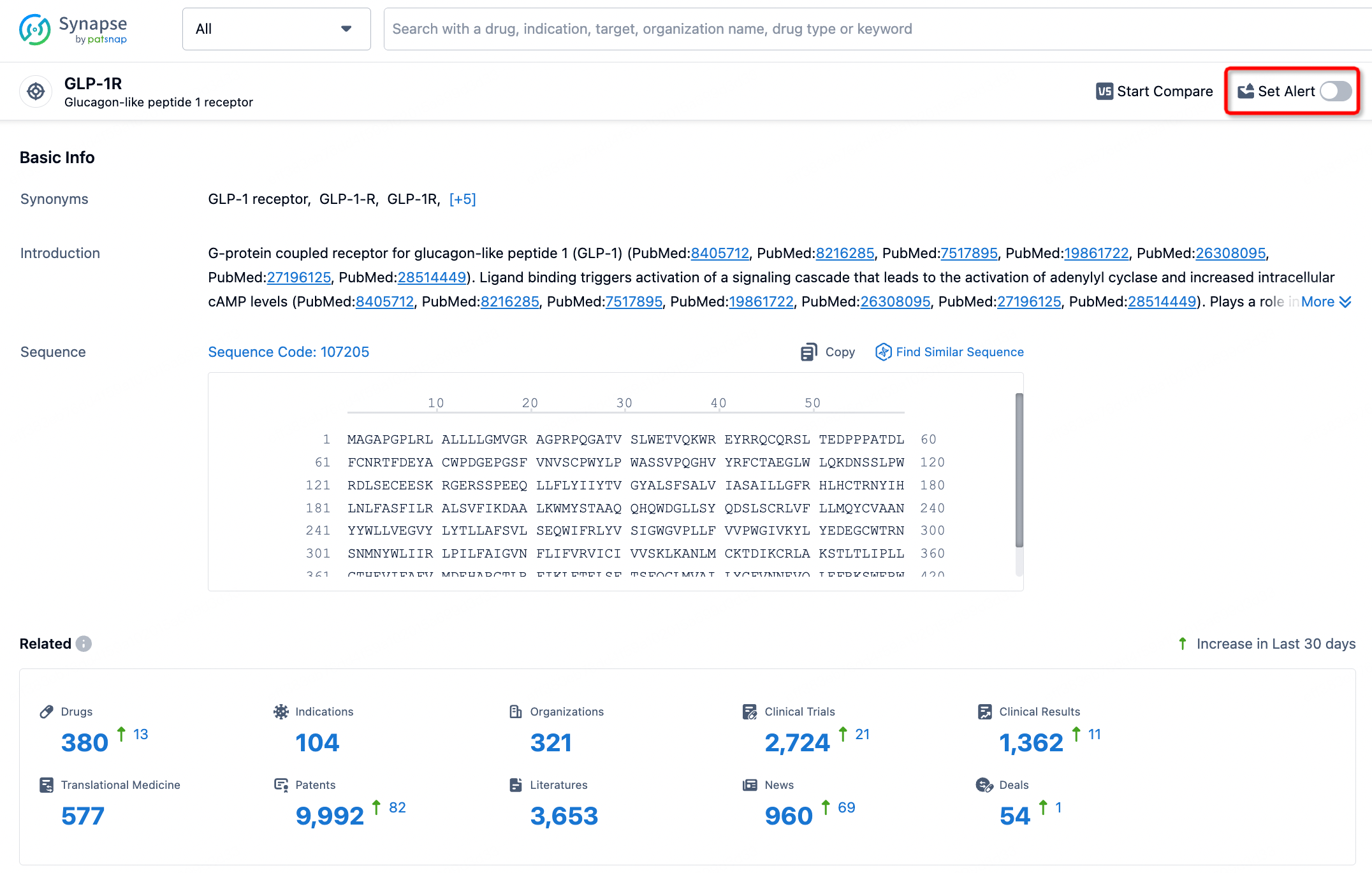Request Demo
What are CNTF agonists and how do they work?
25 June 2024
Ciliary Neurotrophic Factor (CNTF) agonists have garnered significant interest in the scientific and medical communities due to their potential therapeutic applications. CNTF is a cytokine with potent neurotrophic effects, meaning it promotes the survival, development, and function of neurons. Understanding how CNTF agonists work and their potential uses can open doors to new treatments for various neurological and degenerative conditions.
CNTF agonists function by mimicking the activity of natural CNTF, binding to its receptors on the surface of target cells. The primary receptor complex for CNTF consists of a tripartite assembly: CNTFRα (CNTF receptor alpha), LIFRβ (leukemia inhibitory factor receptor beta), and gp130 (glycoprotein 130). When CNTF or its agonist binds to CNTFRα, it triggers the recruitment of LIFRβ and gp130, forming a high-affinity receptor complex. This assembly initiates intracellular signaling cascades that are critical for the survival and differentiation of neurons.
One of the primary pathways activated by CNTF agonists is the JAK/STAT pathway (Janus kinase/signal transducers and activators of transcription). Upon binding of the agonist, JAK kinases associated with the intracellular domains of LIFRβ and gp130 become activated through cross-phosphorylation. Activated JAK kinases then phosphorylate specific tyrosine residues on the receptor, creating docking sites for STAT proteins. These STAT proteins are subsequently phosphorylated, dimerize, and translocate to the nucleus where they modulate the expression of genes involved in cell survival and differentiation.
In addition to the JAK/STAT pathway, CNTF agonists also activate the MAPK/ERK and PI3K/Akt pathways. These signaling routes contribute to cell survival, neuroprotection, and neurite outgrowth by regulating various cellular mechanisms, including metabolism, apoptosis inhibition, and cytoskeletal dynamics.
CNTF agonists have a wide range of potential therapeutic applications, thanks to their ability to support neuronal survival and plasticity. One of the most well-known applications is in the treatment of neurodegenerative diseases, such as amyotrophic lateral sclerosis (ALS) and multiple sclerosis (MS). In ALS, motor neurons degenerate, leading to muscle weakness and eventual paralysis. CNTF agonists can help promote motor neuron survival and slow disease progression. Similarly, in MS, where the immune system attacks the myelin sheath of neurons, CNTF agonists might protect and promote the regeneration of affected neurons.
Another promising application of CNTF agonists is in the treatment of retinal degenerative diseases, such as retinitis pigmentosa and age-related macular degeneration. In these conditions, photoreceptor cells in the retina deteriorate, leading to vision loss. By promoting the survival and function of retinal cells, CNTF agonists have shown potential in preserving vision.
Beyond neurodegeneration, CNTF agonists may also be beneficial in treating traumatic injuries to the nervous system, such as spinal cord injuries. In these cases, the agonists can support the survival and regeneration of damaged neurons, potentially improving functional recovery.
Moreover, CNTF agonists are being explored in the context of metabolic disorders, particularly obesity and type 2 diabetes. CNTF has been shown to influence energy metabolism, appetite regulation, and insulin sensitivity. By activating similar pathways, CNTF agonists might offer new avenues for managing these metabolic conditions.
While the therapeutic potential of CNTF agonists is immense, challenges remain, particularly concerning their stability, delivery, and potential side effects. CNTF is a relatively large protein, and its delivery to the target tissues, especially the central nervous system, can be challenging. Researchers are actively exploring various delivery methods, including gene therapy, encapsulated cell technology, and novel formulations to overcome these hurdles.
In conclusion, CNTF agonists represent a promising area of research with potential applications in treating a variety of neurological and degenerative diseases. By mimicking the activity of natural CNTF, these agonists can promote neuronal survival, differentiation, and function, offering hope for conditions that currently have limited treatment options. As research continues to advance, CNTF agonists may soon become a critical tool in the therapeutic arsenal against neurodegeneration and other related disorders.
CNTF agonists function by mimicking the activity of natural CNTF, binding to its receptors on the surface of target cells. The primary receptor complex for CNTF consists of a tripartite assembly: CNTFRα (CNTF receptor alpha), LIFRβ (leukemia inhibitory factor receptor beta), and gp130 (glycoprotein 130). When CNTF or its agonist binds to CNTFRα, it triggers the recruitment of LIFRβ and gp130, forming a high-affinity receptor complex. This assembly initiates intracellular signaling cascades that are critical for the survival and differentiation of neurons.
One of the primary pathways activated by CNTF agonists is the JAK/STAT pathway (Janus kinase/signal transducers and activators of transcription). Upon binding of the agonist, JAK kinases associated with the intracellular domains of LIFRβ and gp130 become activated through cross-phosphorylation. Activated JAK kinases then phosphorylate specific tyrosine residues on the receptor, creating docking sites for STAT proteins. These STAT proteins are subsequently phosphorylated, dimerize, and translocate to the nucleus where they modulate the expression of genes involved in cell survival and differentiation.
In addition to the JAK/STAT pathway, CNTF agonists also activate the MAPK/ERK and PI3K/Akt pathways. These signaling routes contribute to cell survival, neuroprotection, and neurite outgrowth by regulating various cellular mechanisms, including metabolism, apoptosis inhibition, and cytoskeletal dynamics.
CNTF agonists have a wide range of potential therapeutic applications, thanks to their ability to support neuronal survival and plasticity. One of the most well-known applications is in the treatment of neurodegenerative diseases, such as amyotrophic lateral sclerosis (ALS) and multiple sclerosis (MS). In ALS, motor neurons degenerate, leading to muscle weakness and eventual paralysis. CNTF agonists can help promote motor neuron survival and slow disease progression. Similarly, in MS, where the immune system attacks the myelin sheath of neurons, CNTF agonists might protect and promote the regeneration of affected neurons.
Another promising application of CNTF agonists is in the treatment of retinal degenerative diseases, such as retinitis pigmentosa and age-related macular degeneration. In these conditions, photoreceptor cells in the retina deteriorate, leading to vision loss. By promoting the survival and function of retinal cells, CNTF agonists have shown potential in preserving vision.
Beyond neurodegeneration, CNTF agonists may also be beneficial in treating traumatic injuries to the nervous system, such as spinal cord injuries. In these cases, the agonists can support the survival and regeneration of damaged neurons, potentially improving functional recovery.
Moreover, CNTF agonists are being explored in the context of metabolic disorders, particularly obesity and type 2 diabetes. CNTF has been shown to influence energy metabolism, appetite regulation, and insulin sensitivity. By activating similar pathways, CNTF agonists might offer new avenues for managing these metabolic conditions.
While the therapeutic potential of CNTF agonists is immense, challenges remain, particularly concerning their stability, delivery, and potential side effects. CNTF is a relatively large protein, and its delivery to the target tissues, especially the central nervous system, can be challenging. Researchers are actively exploring various delivery methods, including gene therapy, encapsulated cell technology, and novel formulations to overcome these hurdles.
In conclusion, CNTF agonists represent a promising area of research with potential applications in treating a variety of neurological and degenerative diseases. By mimicking the activity of natural CNTF, these agonists can promote neuronal survival, differentiation, and function, offering hope for conditions that currently have limited treatment options. As research continues to advance, CNTF agonists may soon become a critical tool in the therapeutic arsenal against neurodegeneration and other related disorders.
How to obtain the latest development progress of all targets?
In the Synapse database, you can stay updated on the latest research and development advances of all targets. This service is accessible anytime and anywhere, with updates available daily or weekly. Use the "Set Alert" function to stay informed. Click on the image below to embark on a brand new journey of drug discovery!
AI Agents Built for Biopharma Breakthroughs
Accelerate discovery. Empower decisions. Transform outcomes.
Get started for free today!
Accelerate Strategic R&D decision making with Synapse, PatSnap’s AI-powered Connected Innovation Intelligence Platform Built for Life Sciences Professionals.
Start your data trial now!
Synapse data is also accessible to external entities via APIs or data packages. Empower better decisions with the latest in pharmaceutical intelligence.


